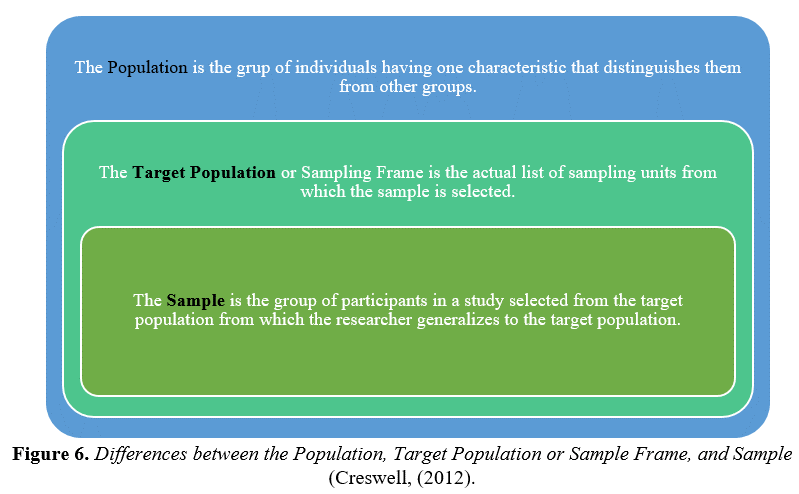Information

In scientific research, terms such as population, sample, study group, or participants refer to people, situations, thoughts, or objects on which research is conducted. Depending on the type of study to be conducted, your ability to reach the population you will work on and the result you want to achieve, the type and the size of the population may vary. Thus, identifying the population and determining the sample size is crucial for generalizability and validity (Cohen, Manion, & Morrison, 2013). For example, in one quantitative study, the population could include academics from various disciplines and career levels but in qualitative study researcher can work with just one scholar for getting deeper information from his or her thoughts and specific experiences on the current research topic. Also, in qualitative studies researchers should take “participants” in their studies and take into account the participants’ main features, thoughts, perspectives…etc. as different variables affect the results of the study. On the other hand, the population, target population, and sample terms have different features. In Figure 6 Creswell’s classification on them was given.

In academic studies, due to the various reasons, researchers usually are not able to reach entire the research population. Thus, choosing correct sampling which successfully represent the whole is crucial. Sampling methods can divide into two parts as random and non-random (purposeful) sampling. Although in purposeful sampling researchers select individuals and sites to learn or understand the central phenomenon intentionally; in random sampling they select representative individuals randomly to generalize results from these individuals to a population (Creswell, 2009). Figure 7, visualize the main sampling methods under the categories of random and non-random sampling.

Figure 7 presents the main sampling methods under the categories of random and non-random sampling. Sampling methods include different strategies that researchers use to select a representative sample from a population. Random sampling methods include methods in which each member has an equal probability of being selected, while non-random sampling methods include methods that guide sample selection based on a particular characteristic of the population. This table provides researchers with guidance in choosing an appropriate sampling method and helps them better understand their sampling strategies. Also, these sampling methods have some advantages and disadvantages. In table 9 they can be seen.

The Table 7 outlines five different sampling methods—Random, Stratified, Cluster, Systematic, and Convenience Sampling—each with specific advantages and disadvantages. Random Sampling is simple and unbiased, but not practical for large populations and may miss minority subgroups. Stratified Sampling ensures proportional representation and facilitates subgroup comparison but requires prior information to divide the population. Cluster Sampling reduces costs by focusing on a limited number of groups, though it may not provide a genuinely random sample and can be less representative. Systematic Sampling is easy to implement and evenly distributes across the population but can introduce bias if the sampling pattern aligns with a population pattern. Lastly, Convenience Sampling is less time-consuming and reduces costs by using an accessible sampling frame but does not represent the population well, introducing significant bias. Each method offers trade-offs between ease of implementation, cost, time efficiency, and the potential for bias, making the choice of method dependent on the specific requirements and constraints of the research study.